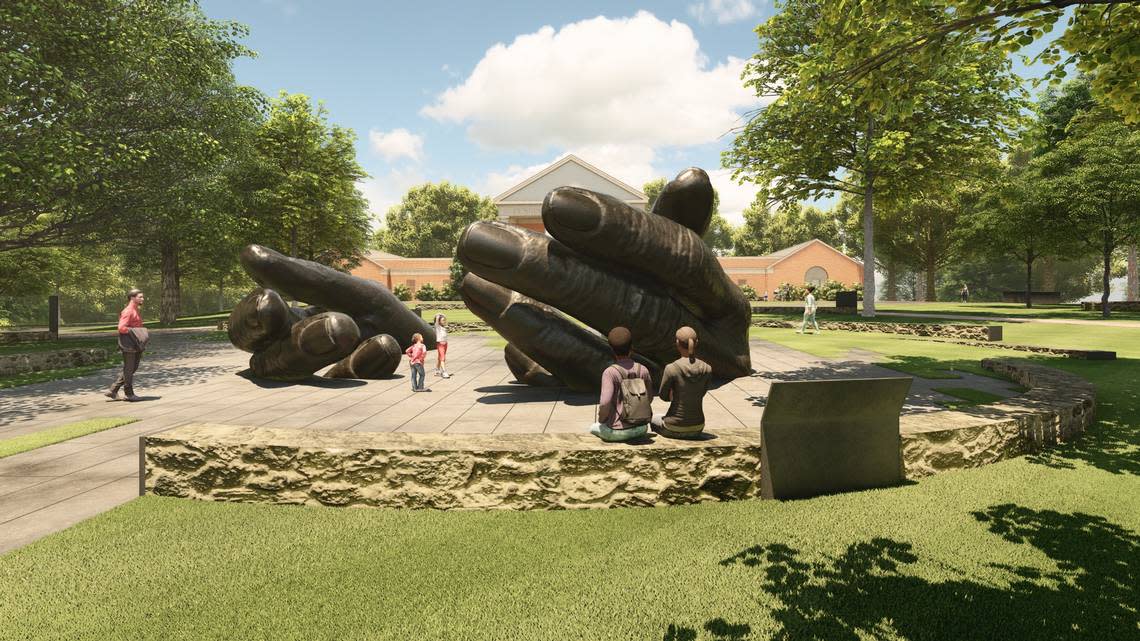Enslaved people built Davidson College and its campus. A new memorial will honor them.

Enslaved people made the bricks for Davidson College’s original buildings, farmed the campus’ land and served its students and faculty.
Nearly two centuries later, the private liberal arts college is taking another step toward reconciling with its past.
Davidson President Doug Hicks announced plans Thursday morning for a memorial to honor the enslaved and exploited people who helped build the college. A bronze sculpture — two large, work-worn hands — will sit among four campus buildings fashioned from those bricks in the mid-1800s.
The memorial, named “With These Hands: A Memorial to the Enslaved and Exploited,” will be visible from Main Street. Work on the sculpture is expected to take two years, with a targeted completion in spring 2025.
“It’s a place of refuge, a place of honor, to commemorate, to grieve, to celebrate and to be accountable,” Virgil Fludd, who graduated from Davidson in 1980, is a college trustee and serves on the commemoration committee said in a news release.
“The hands transcend Davidson, from its beginnings to today to the future,” Fludd said.
Fludd says the sculpture is a collaboration between Charlotte architectural firm Perkins&Will and artist Hank Willis Thomas, and an important way to pay homage.
“Honoring the people who created the institution we endear—that we care so much about—is the very least we could do,” he said.
Still work to do
Fludd, a South Carolina native, was one of the few Black students on campus when he started in 1976. He often felt like he didn’t belong and considered leaving. That he’s a trustee now represents how much Davidson evolved, he says.
“Davidson back then was a far different place,” Fludd said. “It was not the warm, welcoming, diverse environment that it is today.”
Fludd led the process that culminated in the selection of “With These Hands.”
Davidson’s class of 2026 is 33% domestic students of color, according to information provided by the college. Hicks told The Charlotte Observer last week the college has work to do when it comes to diversifying the student body.
Tyler Yvette Wilson, a 2014 graduate of Davidson, teaches at Wesleyan College in Macon, Georgia. She’s an artist whose work focuses on the exploitation of Black and brown communities. Her art has appeared in public venues that include highway billboards in Baltimore’s art district.
“To make a declaration of this magnitude — of this permanence — and invest in it financially is huge,” Wilson said in a news release. “This is not performative, it’s taking real steps to rectify what happened in the past, and that takes a lot of guts.”
‘Black hands built the college’
Davidson resident Bernetta Graham served on the committee that recommended Thomas, of Brooklyn, New York, to create the sculpture. She hopes it will prompt discussions about what transpired and inspire new efforts to help Black residents better understand the legacy of slavery.
“This is a start,” Graham said. “I liked the idea of the Black hands because Black hands built the college. So many of our children don’t know about slavery and don’t understand what was done to our people. Hopefully, this will be educational, to let them know where they came from, and where they can go in the future.”
Fludd wants the memorial to be a lasting symbol.
“I want it to be a boomerang, not just a one-time experience, but where people feel compelled to learn more,” Fludd said. “The college should feel like it’s made a tremendous statement, that it has brought to light things that were not exposed or revealed in the past and that there’s more work to be done.”
Starting with an apology
Davidson College apologized in 2020 for supporting slavery during its first 30 years in the 19th century — and for what the college called “its embrace of the racist laws and policies” in subsequent decades, The Observer reported.
The apology followed a two-year examination of the college’s ties to slavery and racist policies by a campus commission Davidson alumnus Anthony Foxx, the former Charlotte mayor and U.S. Secretary of Transportation, headed.
At the same time, nearly 1,000 supporters signed a Change.org petition calling for Davidson to rename the Chambers building located in the center of campus.
Maxwell Chambers, the slave owner for whom the building is named, left $260,000 to the college when he died in 1855 — the largest donation at the time to an antebellum college in the South, according to the Davidson College Archives & Special Collections website.
Davidson has yet to change the building’s name.
Colleges who have acknowledged their role in slavery
Davidson is one of multiple colleges and universities in recent years to acknowledge their past role in slavery.
In 2021, Virginia lawmakers passed a bill requiring the five public universities built before the Civil War ended that used enslaved laborers to address their history with slavery — including searching for enslaved people and their descendants.
They were required to make reparations through scholarships or community-based economic development and memorial programs starting in 2022, according to the University of Virginia’s news release.
Harvard University released a report last year detailing its ties to slavery and plans for reparations. In 2021, Yale University held a three-day conference where Yale researchers and other people discussed discoveries the university had slavery ties.
While an increasing number of colleges have recognized they benefited from slavery, only a few have built memorials, says Jody Allen, a professor at The College of William & Mary and an expert on commemoration efforts across the country.
William & Mary, Brown University and the University of North Carolina-Chapel Hill are among schools that have memorials.
“Acknowledgment is extremely important,” Allen said. “We must acknowledge them as human beings with lives and desires and dreams. Their contributions helped build this country and these institutions. They need to be remembered.”

